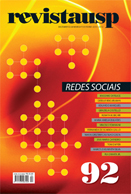SUBORDINATION CONTESTED SPACES AND THE SOCIAL NETWORKS
DOI:
https://doi.org/10.11606/issn.2316-9036.v0i92p20-31Keywords:
social media, Web 2.0, activism, hacktivism, targeted advertising.Abstract
This article deals with the ambivalences of social networks as spaces for controlling and for nurturing new social and cultural expressions. It highlights the procedures of colonizing perception and of corporatization of subjectivities in resources of targeted marketing present in contexts such as the ones on Facebook, and places as opposed to them projects of alternative networks and activism. Starting from the observation that social networks are one of the key features of contemporary urban society, the article investigates the way in which its tensions bring about dynamics of striation (stratification and appropriation) of the informational space, as well as freedom for their becomings and potentialities. It concludes that today those networks offer possibilities of cultural change, which are conducted by social movements, as they propose and trigger disruptions in power relations in current media ecology.
Downloads
References
ARRINGTON, Michael. “The Age of Facebook TechCrunch”, in TechCrunch. 25 de April de 2010. Disponível em: http://techcrunch.com/2010/04/25/the-age-of-facebook. Acessado em: 21 de novembro de 2011.
BRUNS, Axel. “Produsage: A Working Definition”, in Produsage, 2007. Disponível em: http://produsage.org/produsage. Acessado em: 21 de novembro de 2011.
CASTELLS, Manuel. Communication Power. Nova York, Oxford University Press, 2009.
CASTELLS, Manuel; FERNANDÉZ-ARDÈVOL, Mireia; QIU, Jack Linchuan; ARABA, Sey. Mobile Communication and Society – A Global Perspective. Cambridge, MIT Press, 2006.
DELEUZE, Gilles; GUATTARI, Félix. Mil Platôs. Capitalismo e Ezquizofrenia, vol. 5, São Paulo, Editora 34, 2005.
HATEBOOK. http://www.hatebook.org. Acessado em: 21 de novembro de 2011.
LIPOVETSKY, Gilles. O Império do Efêmero – a Moda e Seu Destino nas Sociedades Modernas. Tradução de Maria Luisa Machado. São Paulo, Companhia das Letras, 2009.
LOVINK, Geert; PATELIS, Korinna. “New INC Research Network: Unlike Us – Understanding Social Media Monopolies and their Alternatives”, in Institute of Network Cultures. 15 de July de 2011. Disponível em: http://networkcultures.org/wpmu/weblog/2011/07/15/new-inc-research-network-unlike-us-understanding-social-media-monopolies-andtheir-alternatives. Acessado em: 21 de novembro de 2011.
LUDOVICO, Alessandro; CIRIO, Paolo. Face to Facebook. Disponível em: http://www.faceto-facebook.net. Acessado em: 21 de novembro de 2011.
ONLINE SCHOOL. “State of the Internet 2011”. Disponível em: http://www.onlineschools.org/state-of-the-internet. Acessado em: 21 de novembro de 2011.
QUIT FACEBOOK DAY. http://www.quitfacebookday.com. Acessado em: 21 de novembro de 2011.
REIS, Abel. “Marcas e Mundos Virtuais”, in Trópico, 7 de maio de 2007. Disponível em: http://p.php.uol.com.br/tropico/html/textos/2860,1.shl. Acessado em: 21 de novembro de 2011.
ROSSITER, Ned. “YourSpace Is Mytime, or, What Is the Lurking Dog Going to Do – Leave a Comment?”, in re-public. 2 de novembro de 2007. Disponível em: http://www.republic.gr/en/?p=260. Acessado em: 21 de novembro de 2011.
RUSHKOFF, Douglas. Life.Inc. – How the World Became a Corporation and How to Take it Back. Nova York, Random House, 2009.
SCHOFIELD, Jack. “Facebook’s Social Advertising System and the Rise of the Fansumer| Technology | guardian.co.uk ”, in guardian.co.uk . 7 de novembro de 2007.
Disponível em: http://www.guardian.co.uk/technology/blog/2007/nov/07/facebookssocialadvertisings. Acessado em: 21 de novembro de 2011.
SENNETT, Richard. La Corrosión del Carácter – Las Consecuencias del Trabajo en en el Nuevo Capitalismo. Tradução de Daniel Najmía. Barcelona, Anagrama, 2006.
STELTER, Brian. “Videos Carry On the Fight Over Sea Raid”, in New York Times. 1o de junho de 2010. Disponível em: http://www.nytimes.com/2010/06/02/world/middleeast/02media.html?scp=8&sq=brian%20stelter&st=cse. Acessado em: 21 de novembro de 2011.
SUSTER, Mark. “Social Networking: The Future TechCrunch”, in TechCrunch. 5th de december de 2010. Disponível em: http://techcrunch.com/2010/12/05/socialnetworking-future/. Acessado em: 21 de novembro de 2011.
THE 1000 MOST-VISITED sites on the web. Double Click Ad Planner. 2010. Disponível em: http://www.google.com/adplanner/static/top1000/. Acessado em: 21 de novembro de 2011.
VESNA, Victoria (ed.). Database Aesthetics – Art in the Age of Information Overflow. Minesotta, Univeristy of Minesotta Press, 2007.
WALLER, Angie. Myfrienemies.com. http://www.myfrienemies.com. Acessado em: 21 de novembro de 2011.
WELLMAN, Barry; QUAN-HAASE, Anabel; BOASE, Jeffrey; CHEN, Wenhong. “The Social Affordances of the Internet for Networked Individualism”, in Journal of ComputerMediated Communication, 2003 April. Disponível em: http://jcmc.indiana.edu/vol8/issue3/wellman.html.
Downloads
Published
Issue
Section
License
Copyright (c) 2023 Revista USP

This work is licensed under a Creative Commons Attribution-NonCommercial-ShareAlike 4.0 International License.
|
Pertence à revista. Uma vez publicado o artigo, os direitos passam a ser da revista, sendo proibida a reprodução e a inclusão de trechos sem a permissão do editor. |


